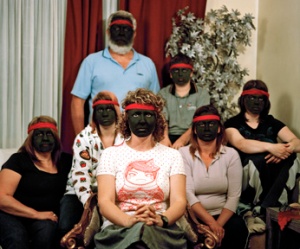Is there ever a good time to use blackface? My initial reaction to that question would be an outright, “No. Never.” Which was why I was surprised when I found the work by Indigenous Australian Bindi Cole entitled Not Really Aboriginal (2008). In a series of photographs Cole depicts several Indigenous family members with faces painted in black minstrel paint and traditional headbands around their heads. Cole states her intentions with this collection in a blog post:
“The first being that when I identified as Aboriginal, people would often respond by saying, but you’re not really Aboriginal. This was because I don’t fit the stereotype of what Aboriginal is ie. living in a remote community, very dark skinned and suffering from dysfunction. However, my grandmother always taught me to identify as Aboriginal and to be proud of the heritage I shared with her.”
In her artwork she also comments on many people’s assumption that she, along with many other Indigenous Australians, only chose to identify as Aboriginal in order to reap the amazing so-called “benefits” that came along with the identity.

This artwork was hugely important in creating discussion about what it means to be Aboriginal and addressing stereotypes. In 1981 a ‘Report on a Review of the Administration of the Working Definition of Aboriginal and Torres Straight Islanders’ proposed that the definition of an Aboriginal or Torres Straight Islander is a person :
- “Of Aboriginal or Torres Straight Islander descent
- who identifies as an Aboriginal or Torres Straight Islander AND
- is accepted as such by the community in which he/she lives.”
In no way does this definition mention skin colour, living arrangements or financial situations and yet still these ideas of the “poor, country Aboriginal” is constantly perpetuated in our media. Which is why artworks like Not Really Aboriginal are important, if not imperative.
Which brings me back to my question on blackface, and whether it was appropriate in its use by Cole. When it comes down to it, I don’t think this could be classified as blackface. Yes, these people are painted with minstrel paint, but the intention is not to mock or make a fool of. Instead it is subverting and reclaiming what once was (and arguably still is) a prominent tool of oppression in order to make a statement about othering in Australia. Not only this but the added confrontation of what in normal circumstances would be considered heinous causes the viewer to reflect further into the issue.
References:
Khan, J, Harvey, J L & Cole, B 2008, Not Really Aboriginal, Centre for Contemporary Photography, viewed 12 August 2015, http://www.ccp.org.au/docs/catalogues/BindiCole.pdf
Cole, B 2011, Not Really Aboriginal…, Bindi Cole Chocka, weblog, October 26, viewed 12 August 2015, http://bindicole.blogspot.com.au/2011/10/not-really-aboriginal.html
Watson, B 2013, ‘Facing up to the Stereotypes’, The Australian, November 16, viewed 12 August 2015, http://www.theaustralian.com.au/arts/review/facing-up-to-the-stereotypes/story-fn9n8gph-1226759272154
Creative Spirits 2015, Aboriginal Identity: Who is ‘Aboriginal’?, Creative Spirits, viewed 12 August 2015, http://www.creativespirits.info/aboriginalculture/people/aboriginal-identity-who-is-aboriginal#top
Cole, B 2008, Wathaurung Mob, photograph, Centre of Contemporary Photography, viewed 12 August 2015, http://4.bp.blogspot.com/-z0krpZUZ5j8/Tqc8DEPeKVI/AAAAAAAAAM4/pXEykNMCakk/s1600/Wathaurung+Mob.jpg